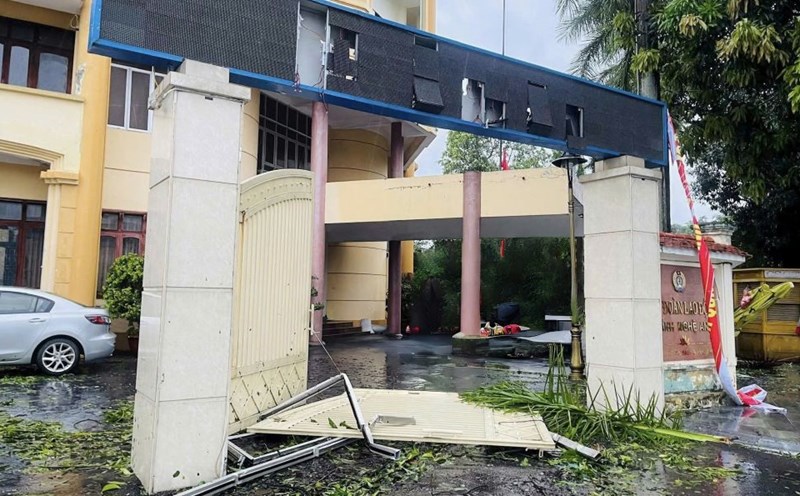The dispatch stated that according to the bulletin of the National Center for Hydro-Meteorological Forecasting, on the morning of August 26, storm No. 5 weakened into a tropical depression in the Central Laos area; at 07:00, the center of the tropical depression was at about 18.9 degrees North latitude; 103.9 degrees East longitude, in the Central Laos area. The strongest wind near the center of the tropical depression is level 6 (39-49km/h), gusting to level 8; moving in the West Northwest direction at a speed of about 20km/h.
From early morning on August 26, the Northern Midlands & Delta, Lao Cai, Son La, Thanh Hoa - Ha Tinh: 50100mm, some places >200mm, risk of heavy rain >100mm/3 hours.
To focus on emergency response to storm No. 5 and implement the direction of the Prime Minister in Official Dispatch No. 146/CD-TTg dated August 25, 2025, the Ministry of Construction requires agencies and units to urgently carry out a number of following tasks:
Heads of agencies and units closely monitor the storm's developments, continue to implement Official Dispatch No. 46/CD-BXD dated August 23, 2025, Official Dispatch No. 47/CD-BXD dated August 24, 2025 of the Ministry of Construction and Official Dispatch No. 54-CV/DU dated August 25, 2025 of the Party Committee of the Ministry of Construction on proactively responding to storm No. 5 (international name Kajiki); do not be negligent, subjective, focus on leading, directing, and effectively implementing measures to overcome storm No. 5 and floods caused by storms with the most urgent and drastic spirit, ready to deploy the fastest recovery of natural disaster and flood consequences to ensure activities to celebrate the 80th anniversary of National Day on September 2 and the opening of the new school year to ensure safety, joy and openness for the people.
The Vietnam Road Administration directs its affiliated units to proactively deploy work to overcome the consequences of floods and ensure smooth traffic, ensuring safety for people and vehicles traveling on national highways and expressways.
In particular, the Department needs to focus on inspecting and reviewing areas at risk of flooding, landslides, and flash floods to have a plan to handle and remote traffic flow.
Arrange guards and guide traffic at locations at risk of deep flooding and rapid flow, especially through culverts, spillways, ferry terminals, pontoon bridges, and ferries; assign guards, put on buoys, barriers, and signals at locations where roads are deeply flooded, culverts, broken sections of roads, landslides, etc., resolutely not allowing people and vehicles to pass when there is still a risk of unsafety.
For locations with large landslides and slides causing traffic congestion, leaders of Road Management Zones must immediately be sent to the scene to coordinate with localities, immediately deploy a remote diversion plan, urgently fix the problem, mobilize maximum machinery, equipment and human resources in the area to ensure traffic opening in the fastest time.
Note that it is necessary to ensure the safety of forces and vehicles participating in overcoming flood incidents to ensure traffic safety.
The Vietnam Railway Authority and Vietnam Railway Corporation direct units to strictly implement patrolling regimes, locking down vulnerable works, locations, and key areas such as bridges, weak roads, prone to flooding; areas prone to flash floods, steep mountain pass sections often with fallen rocks, collapsed soil, railway areas downstream of dykes, irrigation dams, and reservoirs.
The Railway Department must direct units to focus on means, materials, equipment and human resources to overcome the consequences of floods and ensure smooth traffic in the fastest time.
There is a plan to stop the ship, extend the ship, increase the speed limit, and transfer passengers when the flood situation causes flooding and landslides in the areas where the ship must be stopped.
The Vietnam Maritime and Waterway Administration directs its affiliated units to coordinate with relevant local units in guiding anchorage areas, safe shelters for vehicles and taking measures to ensure the safety of people and vehicles when an emergency occurs; requiring vehicles anchored near river bridges to urgently move to safe locations, absolutely not allowing vehicles to crash into river crossing structures.
Urge units managing and maintaining inland waterways to promptly recall buoys and signals before floods or when receiving flood discharge notices from the Civil Defense Commands of localities; promptly re-deploy buoy systems and signals immediately after floods.
The Department of Construction of localities in areas affected by storm No. 5 closely coordinates with local levels and sectors, Road Management Zones and units managing, maintaining and repairing roads, railways and waterways to proactively overcome incidents caused by floods, conduct traffic flow, ensure traffic on roads and waterways assigned to management; coordinate with the road, railway, maritime and waterway sectors in managing transportation, increasing congestion, and transporting passengers and goods when required.











